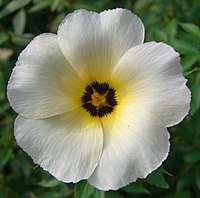
Photo from wikipedia
The economic value of fig trees has been globally acknowledged due to their utilization in the food industry, being also frequently used in traditional medicine. While ubiquitously distributed in Southeast… Click to show full abstract
The economic value of fig trees has been globally acknowledged due to their utilization in the food industry, being also frequently used in traditional medicine. While ubiquitously distributed in Southeast Asia, Ficus curtipes Corner remains uninvestigated concerning its biological properties and chemical profile. HPLC-DAD-ESI/MSn characterization of methanol extracts obtained from the stem bark and leaves allowed the identification and quantitation of 21 phenolic compounds for the first time; the stem bark was predominantly rich in flavan-3-ols and apigenin derivatives, while solely apigenin-di-glycosides have been identified and quantitated on the leaf extract. Both extracts inhibited 5-lipoxygenase (5-LOX) activity in a concentration-dependent manner, the one obtained from the stem bark being significantly more active (IC50 = 10.75 μg/mL). The effect of both extracts on lipopolysaccharide (LPS)-stimulated RAW 264.7 macrophages was evaluated, and while the stem bark extract did not lead to a noticeable interference on nitric oxide (NO) levels, the extract obtained from the leaves notably decreased NO and L-citrulline levels at concentrations ranging from 250 to 500 μg/mL. Herein, F. curtipes is valorized due to its modulatory effects on inflammatory mediators and also as a source of bioactive phenols, which may fuel further studies on the development of nutraceuticals.
Journal Title: Biomolecules
Year Published: 2019
Link to full text (if available)
Share on Social Media: Sign Up to like & get
recommendations!